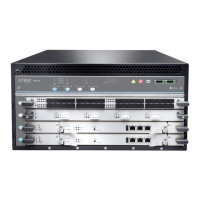4. Carefully align the transceiver with the slots in the component. The connectors should
face the component.
5. Slide the transceiver until the connector is seated in the component slot. If you are
unable to fully insert the transceiver, make sure the connector is facing the right way.
6. Close the ejector handle of the transceiver.
7. Remove the rubber safety cap from the transceiver and the end of the cable. Insert
the cable into the transceiver.
WARNING: Do not look directly into a fiber-optic transceiver or into the
ends of fiber-optic cables. Fiber-optic transceivers and fiber-optic cable
connected to a transceiver emit laser light that can damage your eyes.
8. Verify that the status LEDs on the component faceplate indicate that the SFP or XFP
is functioning correctly. For more information about the component LEDs, see the MX
Series Interface Module Reference.
Related
Documentation
MX240 Dense Port Concentrator (DPC) Description on page 49•
• MX240 PIC Description on page 59
• MX240 Modular Port Concentrator (MPC) Description on page 77
• MX240 Modular Interface Card (MIC) Description on page 70
• Replacing a Cable on an MX240 DPC, MPC, MIC, or PIC on page 320
• Removing an SFP or XFP Transceiver from an MX240 DPC, MPC, MIC, or PIC on page 323
• Preventing Electrostatic Discharge Damage to an MX240 Router on page 444
Installing an MX240 AC Normal-Capacity Power Supply
To install an AC power supply (see Figure 104 on page 257):
1. Attach an ESD grounding strap to your bare wrist and connect the strap to one of the
ESD points on the chassis.
2. Move the AC input switchnext to the appliance inlet on the power supply to the off (O)
position.
3. Using both hands, slide the power supply straight into the chassis until the power
supply is fully seated in the chassis slot. The power supply faceplate should be flush
with any adjacent power supply faceplate or blank installed in the power supply slot.
Copyright © 2017, Juniper Networks, Inc.256
MX240 3D Universal Edge Router Hardware Guide

